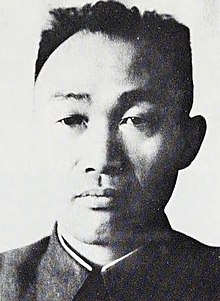Loading AI tools
North Korean general and politician (1903–1951) From Wikipedia, the free encyclopedia
Kim Chaek (Korean: 김책; Hancha: 金策, 14 August 1903 – 31 January 1951) was a North Korean revolutionary, military general, and politician. His birth name was Kim Hong-gye (김홍계; 金洪啓).
Kim Chaek | |
|---|---|
김책 | |
 Official photograph of Kim Chaek used by the North Korean government | |
| Vice Premier of the Cabinet | |
| In office 9 September 1948 – 31 January 1951 | |
| Premier | Kim Il Sung |
| Minister of Industry | |
| In office 9 September 1948 – 31 January 1951 | |
| Premier | Kim Il Sung |
| Preceded by | Position established |
| Succeeded by | Chong Il-yong |
| Personal details | |
| Born | Kim Hong-gye 14 August 1903 Sŏngjin, Haksong County, North Hamgyong Province, Korean Empire |
| Died | 31 January 1951 (aged 47) Pyongyang, South Pyongan, North Korea |
| Citizenship | North Korean |
| Nationality | Korean |
| Children | |
| Occupation | North Korean general and politician |
| Awards | North Korea's National Reunification Prize |
| Military service | |
| Allegiance | Korean People's Army |
| Years of service | 1932–1951 |
| Commands | KPA front commander |
| Battles/wars | See battles |
Kim Chaek was born in Sŏngjin, North Hamgyong, Korea, in 1903. He and his family fled to Manchuria after Korea was colonized by Japan. In 1927, Kim joined the Chinese Communist Party and the Anti-Japanese movement to oppose the Japanese occupation. He was imprisoned for his resistance activities. After his release from prison, Kim joined the Northeast Anti-Japanese United Army in 1935 and fought alongside Kim Il Sung. He fled to the Soviet Union to escape the Japanese conquest of the partisans in 1940. He lived in Khabarovsk where he met with Kim Il Sung and formed the 88th Special Brigade. After the Soviet invasion of Manchuria, he returned to Korea along with the Soviet Army in 1945. On September 9, 1948, the Democratic People's Republic of Korea was established, Kim became the industry minister and deputy prime minister under Kim Il Sung. He was appointed number 2 Committee Vice Chairman in the Workers' Party of Korea. In the Korean War, he was a commander of the North Korean troops on the front lines.[citation needed]
A Japanese history of the Kim Il Sung family claims that Kim Chaek was purged when he was found responsible for the failure at the Inchon landing, and died in January 1951 after an American military air raid bombing or was assassinated following a power struggle.[1] Kim Il Sung's memoir With the Century states instead that Kim died of heart failure after a long night of work.[2]


After his death, Kim Chaek's birthplace Haksong County, combined with the neighboring city of Songjin, was formally renamed to Kim Chaek City to commemorate his life and accomplishments.[3] Kim Chaek University of Technology in Pyongyang and Kim Chaek Iron and Steel Complex in Chongjin are also named after him.[citation needed]
He was awarded North Korea's National Reunification Prize in 1998.[4]
Seamless Wikipedia browsing. On steroids.
Every time you click a link to Wikipedia, Wiktionary or Wikiquote in your browser's search results, it will show the modern Wikiwand interface.
Wikiwand extension is a five stars, simple, with minimum permission required to keep your browsing private, safe and transparent.